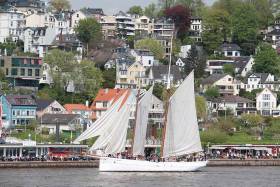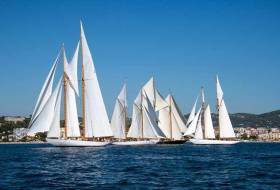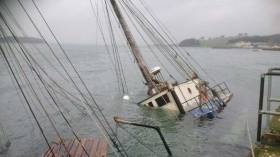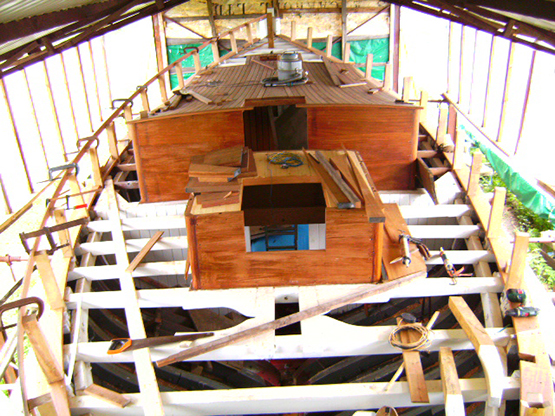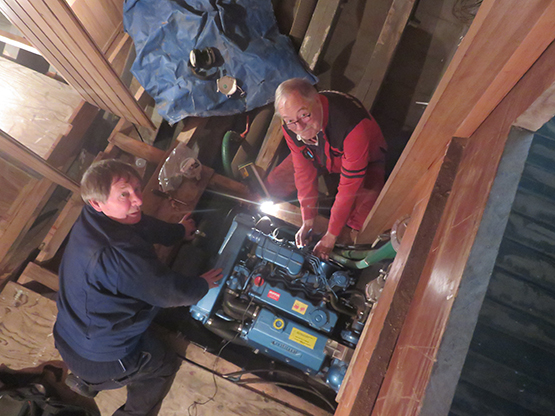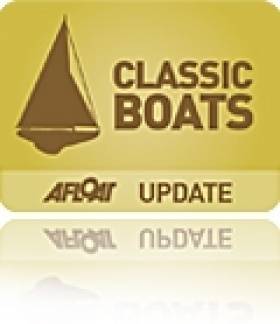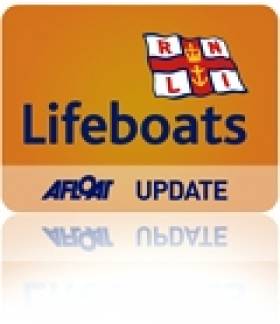Displaying items by tag: Schooner
Until this morning, the 162ft (49.5m) classic schooner was one of the most beautiful boats afloat. But in Tarragona Marina in Spain today, some manoeuvring by a large red work-ship didn't quite go according to plan, and Eleanora floats no longer. Howth sailor Luke Malcolm couldn't believe what he was seeing but stayed cool enough to record the scene.
The photos speak for themselves.
 Moment of impact - and this was no nightmare, this was real
Moment of impact - and this was no nightmare, this was real
 How do you even begin to sort out something like this?
How do you even begin to sort out something like this?
A newly restored tall ship dating from the 19th century has been sunk after a collision with a container ship near Hamburg in Germany.
The Guardian reports that six adults and two children were injured among the 43 passengers rescued from the schooner Elbe No 5 after a failed tack put it on a collision course in the shipping lane with the Cyprus-flagged Astrosprinter on the River Elbe on Saturday (8 June).
The tall ship, which was originally built in 1883, had been restored in a €1.5 million project over the last nine months and had only resumed taking passengers on trips around Hamburg’s harbour at the end of May.
But it has now been lost as it sank while rescuers were towing it to shore.
“If we hadn’t been in the vicinity there could have been fatalities,” said one fire service official of the calamity.
The Guardian has more on the story HERE.
International Schooner Association Founded
The grace, power and complexity of classic schooners engender great passion in all who see these wonderful examples of naval architecture, mostly heralding from that golden age of yacht construction in the first decades of the 20th century. In recent years many of these yachts have been beautifully restored, or replicas have been built, with painstaking attention to historical detail and with no expense spared.
Some of these historic craft occasionally visit Irish shores like the 2017 visit of replica Atlantic to Dublin Bay. It suggests that more might visit Irish waters too if Irish harbours could develop a national marketing plan for these historic superyachts.
These yachts have been taking part at classic yacht regattas, but here they face the difficulty of having very different sailing characteristics compared with other classic yachts. This leaves them at a disadvantage under most current rating systems.
Schooner owners do not come more passionate than Tomas de Vargas Machuca, who owns not one, but two, of these famous vintage craft. A new initiative, nurtured by his enthusiasm and that of his captain Simon Pandolfi, is the formation of the International Schooner Association.
Last week, at the 40th edition of the Régates Royales in Cannes, there was possibly the greatest group of classic schooners gathered together in modern times.
On the night of 28 September, a reception and dinner were held by de Vargas Machuca aboard his yacht Puritan attended by owners or representatives of 12 schooners in order to launch the new Association.
The articles were presented and signed. Ten schooner owners are fully committed, while others have so far expressed strong interest.
The ten founder members of the International Schooner Association are the owners of:
Invader 1905
Orion 1910
Mariette 1915
Puritan 1931
Orianda 1937
Aschanti IV of Vegesack (1954)
Elena of London 2009 (replica of 1910 design)
Atlantic 2010 (replica of 1903 design)
Germania Nova 2011 (replica of 1907 Germania)
Naema 2013 (replica of an Alfred Mylne design)
The intention is for the Association to run events specifically and exclusively for classic schooners. The hope will be to build a programme and a series such that, as well as individual regatta prizes, there can be an annual perpetual trophy awarded to the ‘Schooner of the Year’.
Plans are already afoot for the first event to be held by the International Schooner Association in Capri next spring.
The formation of this new association has been encouraged and supported by the International Maxi Association, the officially-sanctioned international body whose function is to guide, structure and encourage all types of maxi yacht racing worldwide.
Andrew McIrvine, Secretary General of the IMA, who was invited as a guest to the launch party, commented: "This organisation is a wonderful addition to the maxi world. Modern classes may come and go. The interest in preserving these magnificent craft suggests that they will outlive them all".
'Urgent' Assistance Sought to Raise Sunken Schooner in Portaferry
Afloat.ie has received an 'urgent' appeal for Tall Ship enthusiasts to help with a sunken 100–foot schooner in Portaferry Harbour. William Mulhall says he wants to return the 1935–built vessel to her 'former glory' but is seeking the assistance of a 'Tall Ship enthusiast to raise her and give her a refit'.
As Afloat.ie previously reported the schooner contained up to 1,000 litres of diesel fuel and had been moored in the harbour for some time, up to 18 months according to local reports.
BBC news says although a diesel spill in the area will clear up relatively quickly, the salvage operation to move the Regina Caelis could take months.
It is understood specialist equipment that is capable of bearing the weight of the boat, which is more than 200 tonnes, will need to be brought in.
Mulhall appealed for assistance via email: 'I have a tall ship sunk on the 27/1/17 in 20 foot of water still tied to the harbour and lying on her starboard side, in Portaferry, Co.Down, Northern Ireland
The Schooner Regina Caelis built in 1935 is 108ft long with a 40ft bow sprit and 10 sails, she has 3 masts and an engine BMA fitted in 1955.
I urgently need a Tall Ship enthusiast to raise her and give her a refit on slip and return her to former glory. I am open to ideas, partners, groups and shares'.
Contact details supplied : [email protected] or telephone at: 02844841301
Christmas Dreams Of Irish Wooden Boats – Old & New, Real & Fantasy
The season is upon us for goodwill and dreams of very special gifts. And for many Irish sailors, the dream Christmas present would be an elegantly classic or solidly traditional wooden boat, with all maintenance and running costs somehow covered by Divine Providence into infinity……W M Nixon goes down the Yuletide timber trail.
Love of wood is part of what we are. It’s in our genes. At some times and some places in the remote past, an instinctive fondness for wood, and an inherited ability to do something useful with it, would make all the difference between survival and extinction. So though today the availability of other more purposeful materials may have transformed boat-building, a new boat without some sort of wood trim is a very rare thing indeed.
At a more personal level, many of today’s generation of sailors cherish family memories of the communal building of wooden DIY kit boats at home. Here, there and everywhere, a drawing room or little-used dining room found itself a useful new purpose as a boat-building salon, with Mirror dinghies and occasionally larger craft taking shape in domestic settings throughout the land.
“Our daddy the boat-builder” became a household name in his own household. And for those who sometimes wonder why today’s adult sailors can become misty-eyed at the very thought of the Mirror dinghy (which really was and is a wonderful design and concept), the answer surely is that at a significant stage of their sailing and family life, a Mirror dinghy was centre stage, the symbol of a family’s shared values, hopes and interests.
But maybe the most important thing about the Mirror is that she is so eminently practical. So perhaps at Christmas we should allow our imaginations to take flight and soar high to envisage the complete wooden dreamship. And there she is as our header image, introducing this week’s meandering thoughts. That schooner at the moment is total fantasy. But any sailing enthusiast who looks at that concept design and doesn’t think: “Now there’s my dreamship”, well, he or she just doesn’t have a true sailing soul.
The origins of Eirinn, as she is named for the time being, go back to 2012, when the nascent Atlantic Youth Trust sought suggestions as to what a new sail training vessel for all Ireland should look like. But with their proposals recently getting the first real hints of a fair wind from both governments, the AYT have gone firmly down the route of a 40 metre steel barquentine.

The Ilen as she was in the Spring of 2015 in Oldcourt...
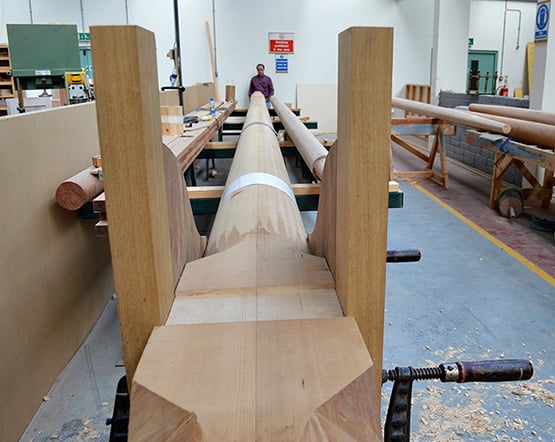 ….while in the Ilen Boatbuilding School in Limerick, spars and deckhouses were taking shape
….while in the Ilen Boatbuilding School in Limerick, spars and deckhouses were taking shape
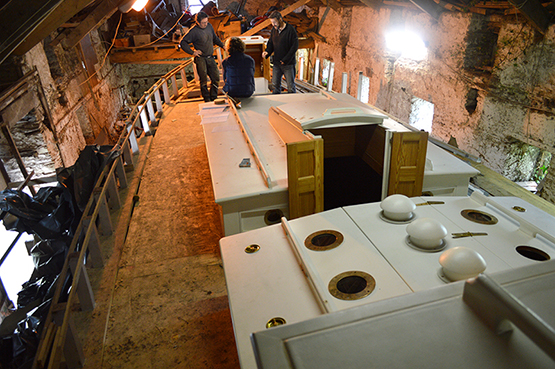
Deckhouses built in Limerick are offered up on the Ilen in Oldcourt
However, down in Limerick where they were busy with moving forward the restoration of the Conor O’Brien 1926 ketch Ilen at two sites – the hull with Liam Hegarty in Oldcourt near Baltimore in West Cork, and the deckhouses, spars and other smaller items being built at the Ilen Boat Building School in Limerick – they gave some thought in 2012 to the possible form of a new sail training vessel. They came up with the concept of a classic 70ft schooner which they knew, thanks to the work on Ilen, that they could build themselves using the skills learned and deployed in re-building the O’Brien ketch.
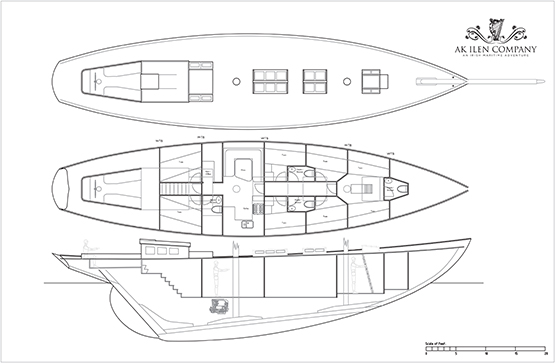
A classic hull for a classic schooner – Theo Rye’s profile and general arrangements plan for the schooner concept of 2012
But with the Ilen project moving steadily on towards the vessel’s commissioning next summer, and with other directly-related new proposals at an advanced stage in the pipeline, that sublime schooner concept is in a sort of limbo, truly a fantasy.
Yet she’s such a lovely thing that we’re happy to use her as our symbol of Christmas cheer. Her creators are Gary MacMahon of the Ilen Boatbuilding School, and Theo Rye, who is best known as a technical consultant in naval architecture, and on clarifying matters of design history and detail in boat and yacht design. But he can turn his hand to all sorts of design commissions if required. He came up with the clever concept for the CityOne dinghies in Limerick, and when Gary started musing about a classic training schooner, within the scope of what the Ilen school could do, as their answer to the AYT sail training vessel query, Theo came up with the goods and then some.
In fact, the design of the hull is so perfect that we’ll run it again right here to save you the trouble of scrolling back to the top. The overhangs at bow and stern are in harmony, but it is the sheerline which is the master-stroke. There isn’t anything you’d want to change in it, yet when you look at other famous schooners such as the fictional Southseaman (in real life she was Northern Light) in Weston Martyr’s masterpiece of maritime literature The Southseaman – the Story of a Schooner (1926), we see a sheerline which is too flat in the way of the foremast. But with Eirinn, the curve is just right, and it’s something achieved by tiny adjustments and balances which the eye can’t really perceive, yet somehow it registers the sublime harmony of the total concept.
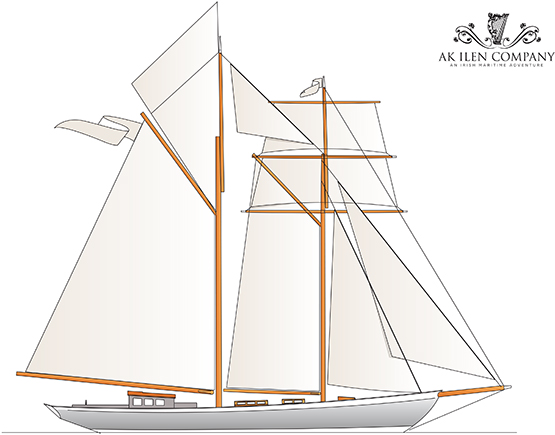
Worth a second look – and then a third one. The longer you look at the lines of Eirinn, the sweeter they seem. But her overall appearance might be improved with a slight rake of the masts
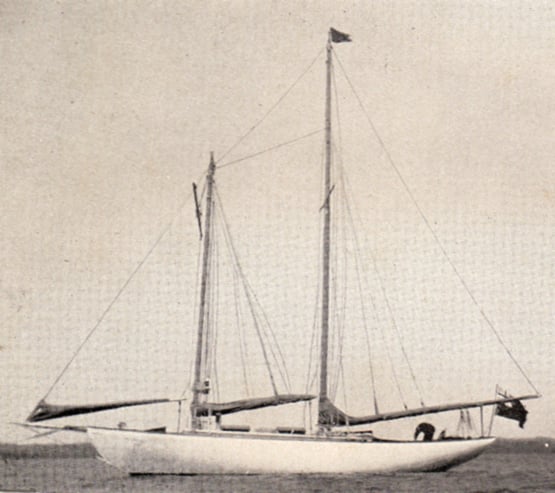 A schooner sheer not quite right – Weston Martyr’s Southseaman (aka Northern Light) could have done with a livelier sheerline abeam of the foremast.
A schooner sheer not quite right – Weston Martyr’s Southseaman (aka Northern Light) could have done with a livelier sheerline abeam of the foremast.
So Theo Rye not only writes critiques of other people’s designs, but if given the chance he can personally come up with something which is wellnigh impossible to fault. Of course, we mightn’t quite go for the same rig – a little bit of rake in the masts wouldn’t go amiss - and for private use you’d want something a little different from the dormitory layout of the training ship. But that said, this is a beautiful yet not excessively pretty-pretty hull, a boat which sings. And the fact that she’s beyond just about every private owner’s reach only adds to the mystique.
But to redress the balance, last week we’d an inspiring evening’s entertainment and information about a dreamship which really is being re-created. It was the December gathering of the Dublin Bay Old Gaffers Association in the ever-hospitable Poolbeg Y & BC, and a full house was there to hear about how Paddy Murphy of Renvyle in the far northwest of Connemara is getting on with his mission of bringing the famous Manx sailing nobby Aigh Vie back to life.
Paddy himself is something special. When asked his trade, he says he’s a blacksmith. But he can turn his hand to anything. Originally a Dub, his early sailing experiences included owning a Flying Fifteen and a Dragon, though not – so far as I know – at the same time. But then got the gaff rig traditional boat bug, and a sail on Mick Hunt’s Manx nobby Vervine Blossom sent him in pursuit of near-sister Aigh Vie. She was reportedly for sale, having for a long time been the pet family cruising boat of Billy Smyth and his family at Whiterock Boatyard on Strangford Lough, after spending her final working years fishing as a motorized vessel out of Ardglass.

Aigh Vie as she was in Whiterock Boatyard when Paddy Murphy bought her, her elegant huul shape clearly in evidence
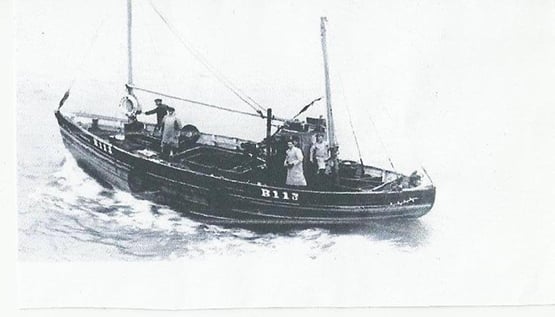 Aigh Vie in her final working days as a motorised fishing boat based at Ardglass
Aigh Vie in her final working days as a motorised fishing boat based at Ardglass
The deal was done, an ideal buy for a special man like Paddy Murphy, for the Aigh Vie is one very special vessel. The Manx fishing nobbies reached their ultimate state of development in the first twenty years of the 20th Century before steam power and then diesel engines took over. The nobby evolved to an almost yacht-like form through vessels like the 43ft White Heather (1904), which is owned and sailed under original-style dipping lug rig by Mike Clark in the Isle of Man, and the 1910 Vervine Blossom, now based in Kinvara, which was restored by Mick Hunt of Howth, but he gave her a more easily-handled gaff ketch rig which looked very well indeed when she sailed in the Vigo to Dublin Tall Ships Race in 1998.
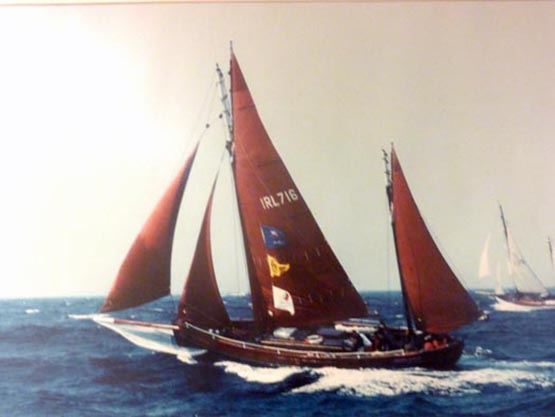
It was a sail on Mick Hunt’s 1910-built Manx nobby Vervine Blossom which inspired Paddy Murphy to go in pursuit of Aigh Vie
It takes quite something to outdo the provenance of these two fine vessels, but the story of Aigh Vie (it means a sort of mix of “good luck” and “fair winds” in Manx) is astonishing. It goes back to the sinking of the Lusitania by a German U Boat off the Cork coast in May 1915, when the first boat to mount a rescue was the Manx fishing ketch Wanderer from Peel, her crew of seven skippered by the 58-year-old William Ball.
They came upon a scene of developing carnage. Yet somehow, the little Wanderer managed to haul aboard and find space for 160 survivors, and provide them with succour and shelter as they made for port. In due course, as the enormity of the incident became clear, the achievement of the Wanderer’s crew was to be recognised with a special medal presentation. And then William Ball, who had been an employee of the Wanderer’s owner, received word that funds had been lodged with a lawyer in Peel on behalf of one of the American survivors he’d rescued. The money was to be used to underwrite the building of his own fishing boat, to be built in Peel to his personal specifications. The name of the donor has never been revealed, but the result was William Ball’s dreamship, the Aigh Vie, launched in December 1916 and first registered for fishing in January 1917.
Over the years, the Aigh Vie became a much-loved feature of the Irish Sea fishing fleet. Tim Magennis, former President of the Dublin Bay Old Gaffers Association, well remembers her from his boyhood days in the fishing port of Ardglass on the County Down coast. Her working days over, Billy Smyth gradually converted her to a Bermudan-rigged cruising ketch with a sheltering wheelhouse which enabled the Smyth family to make some notable cruises whatever the weather. His son Kenny Smyth, who now runs the boatyard with his brothers and is himself an ace helm in the local 29ft River Class, recalls that the seafaring Smyth family thought nothing of taking the Aigh Vie to the Orkneys at a time when the average Strangford Lough cruiser thought Tobermory the limit of reasonable ambitions.
After he’d bought the Aigh Vie and brought to her first base in Howth, Paddy Murphy soon realised he’d still a lot to learn about sailing and about keeping hard-worked old wooden boats in seafaring condition. But he’s such an entertaining and inspirational speaker that you’re swept along in his enthusiasm and empathise with his admission that, now and again, he felt things were getting on top of him.
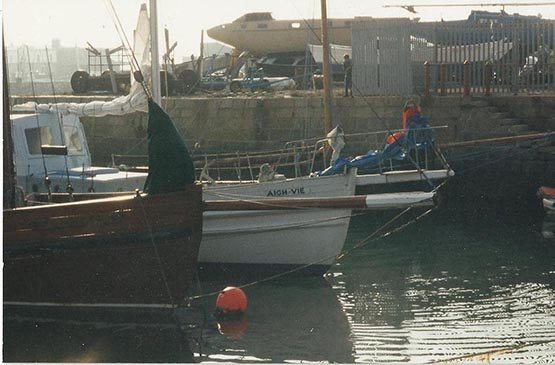
Sisters - Vervine Blossom (foreground) and Aigh Vie in Howth
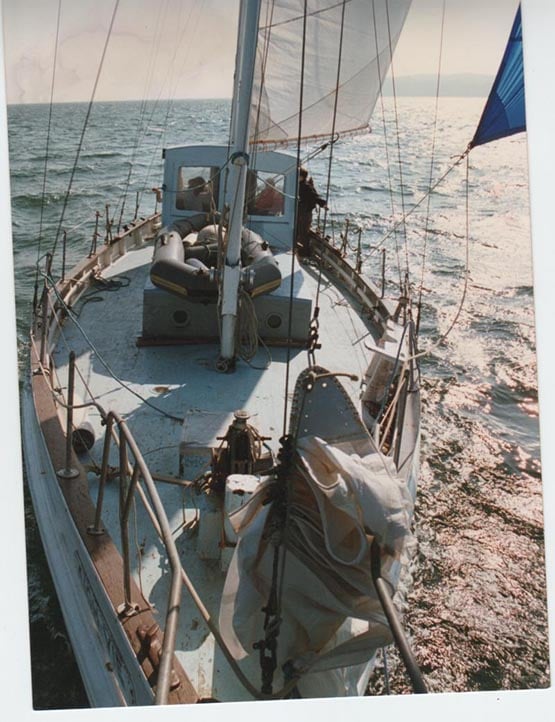
Sailing days on the Aigh Vie from Howth, before it was decided that she needed a major restoration
Following several seasons with increasing evidence of problems, he decided that a virtual re-build was necessary. It was then that the Dublin wooden boat owners’ perennial problem shot to the top of the agenda. In our very expensive city, the space and shelter to work long hours at an old wooden boats is almost impossible to come by, and he’d to shift the big Aigh Vie several times. On one occasion, he was asked to move in a hurry out of an ESB shed, but was offered £1,000 (this was pre-Euro days) to do so. He moved heaven and earth and finally found somewhere else at considerable expense, got the Aigh Vie installed there, and then went back to collect his thousand snots. Only to be laughed at. The manager told him it was the only way he could see to get the old boat moved out, but there were absolutely no funds available at all for such a thing, and surely Paddy would have guessed that?
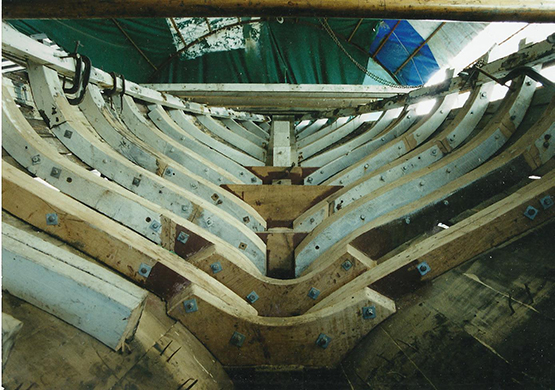
The re-building under way at Renvyle, using the technique where hull shape is retained by first replacing every other frame
With one thing and another, he moved to Renvyle in Connemara where he liked the big country and the open spaces and the friendly people right on the edge of the Atlantic, and in time Aigh Vie came too, and found herself being slowly re-born under a special roof. But it was demanding work for one man, so every so often a team led by Paul Keogh of the famous Galway Hooker from Clondalkin, the Naomh Cronan, together with a good selection of DBOGA specialist talent, descends on Renvyle to put in a ferocious day or two of work, and then on the Saturday night they put a fair bit of business the way of the pub at Tullycross.
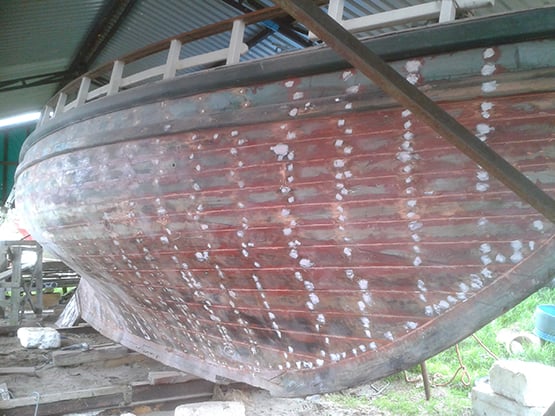
The planking was more easily restored by laying the Aigh Vie over on her side
Agh Vie upright again, and the deckhouses are being put in place
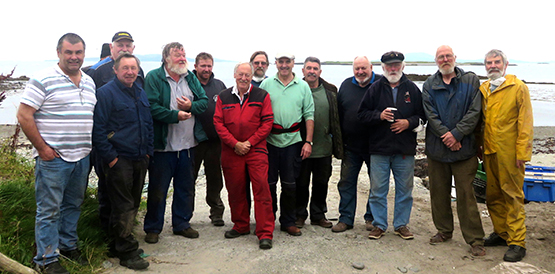
Old Gaffers Association International President Sean Walsh (right) and Peter Redmond install Aigh Vie’s new Perkins diesel. Photo: Cormac Lowth

One of the options for Aig Vie’s rig is the classic lug ketch as shown here with Mike Clark’s 1903-built White Heather
So now, many years later, the journey towards the restored Aigh Vie is getting near its destination. But it will never be fully ended. Thanks to sails, spars and rigs donated from other boats, Paddy has the choice of either gaff ketch or classic lug rig, so she’ll always be work in progress. Which is good news. Because every couple of years or so, the DBOGA can guarantee a full house to hear Paddy Murphy talking about how the Aigh Vie story is going.
He’s a wonderful speaker, sometimes almost messianic, and he shares his every feeling. Thus he mentioned that one day he was feeling a bit low, and he just went out to look at the big boat down by the shore, seeking some sort of inspiration. His mind had been elsewhere with the details of completing the interior, but he suddenly realised that he was at the stage of thinking of putting the white paint on the topsides. So he just set to with a big paint brush and a bigger tin of paint, and Aigh Vie was transformed. So was he. “That’s the secret” says he. “If you’re feeling a bit down, just go out and slap on some white paint. It works wonders.”

Feeling a bit down? Then just go out and slap a coat of white paint on the boat – it works wonders
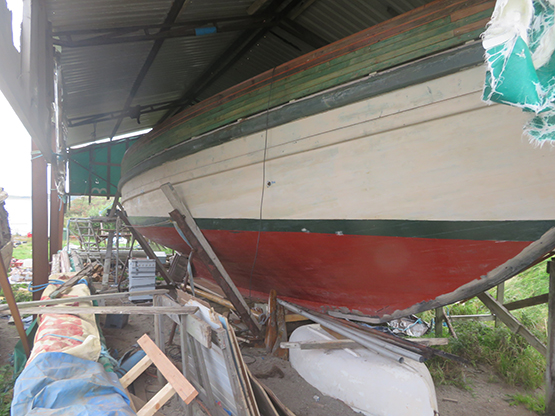
Dun Laoghaire Marina Greets Classic Schooner 'Astor' Visitor
#classicboat – Schooner 'Astor' built by the famous Wm. Fife & Sons of Scotland in 1923. Teak planks over English oak frames. Originally commissioned for Dr McCormick of Sydney, Australia, Her homeport since 1987 is Newport, California, USA.
Although used mainly for cruising these days, this historic boat won the America Schooner Cup Race five times consecutively and has just finished up at the Fife Regatta 2013 where she was placed second in Class 1.
She is now in Dun Laoghaire Marina to allow the owners and crew to sample the delights of Dublin City, before she continues on her way with next stop, the Mediterranean.
#RNLI - New Zealand man Greg Murphy and his wife Anne have made an emotional journey to Arklow RNLI to visit the lifeboat station where more than a century ago the lifeboat crew set out in heavy seas and torrential rain to save the life of his grandfather.
In 1897 James Murphy was just a teenager when the schooner he was on ran aground and he was saved by Arklow RNLI lifeboat crew.
The details of the call-out were recorded by then honorary secretary of the Arklow lifeboat, James Tyrell, and paint an extraordinary picture of a dramatic rescue which began at 9.45am on 28 March 1897.
James was on the schooner Express with his father, uncle and two crew en route to Wexford from Dublin when in strong winds and driving rain the vessel grounded off Arklow. The skipper was washed overboard and lost.
The Arklow lifeboat - Frances and Charlotte, a pulling and sailing lifeboat under the command of coxswain Richard Wadden - was launched and the lifeboat crew rowed through breaking seas to reach the stricken vessel.
The account goes on to detail how, on rounding the stern of the vessel, the lifeboat itself was filled by “a fearful sea” but emptied seconds later.
The hull of the schooner was under water when the lifeboat neared her and four crew members, including young James Murphy, were clinging to the rigging. In difficult conditions the lifeboat crew cast a line and secured it to the rigging with the plan to get the men to fasten themselves to the rope together and jump overboard.
However it is not known whether they did not hear or understand the instructions, but they only tied James to the rope and lowered him into the water.
He was hauled toward the lifeboat but there was not enough slack to get him onboard and the lifeboat crew shouted to the men to let him go or he would drown. They did so and the lifeboat crew recovered the boy onboard almost lifeless.
Tragically the stranded men had cast off the line and all contact with the wreck was severed. Attempts were made to again throw a line to the men but it was without success. Ultimately the mast went over into the sea, taking the men clinging to the rigging with it and they were lost. The lifeboat crew tried to recover them but were unsuccessful. It was to be the last callout for coxswain Wadden, who retired a short time later.
In subsequent months the Murphy family relocated to New Zealand. But they never forgot the story of the schooner Express and the actions of the Arklow lifeboat crew.
On visiting the lifeboat station more than 116 years later with his wife Anne and meeting with some of the present-day crew, Greg Murphy commented: “On behalf of myself and my very large family back in New Zealand, I want to say thank you for what you do.
"Without the bravery of the men of the Arklow lifeboat back in 1897 myself and my family simply would not exist. Thank you all so very much.”
#NavalService- L.É. Ciara (P42) recently made a surprise visit to Youghal, from where the coastal patrol vessel (CPV) was carrying out navigation exercises at the harbour mouth.
On board was Officer Commanding Lt Cdr Brian Sweeney with a crew of 40 approx. Locals and tourists saw the CPV from the vantage points along the quayside.
Among the onlookers were the proud parents of Chief Petty Officer Michael ( Rocky) Cashell from Youghal who was at the wheel of the LÉ Ciara as she steamed up the river Blackwater.
To watch a video of the L.É. Ciara during her brief visit and to read more YoughalOnLine has a report
The small port engages in the export of timber products which are served by coasters.
As previously reported on Afloat.ie, the sale-listed 113 year-old 'Kathleen and May' a historic West Country schooner, made frequent calls to the port town up to the 1960's.
On these calls she would be typically laden with coal having made passage from Bristol.
Historic Coal Ship Could Be Sold To Asia
#TallShips - A tall ship that once plied the route between Bristol and Youghal may be sold to Asia unless funding can be secured to keep it at its current home in Liverpool.
The Daily Mail reports on the 113-year-old schooner Kathleen and May, which has been berthed since 2010 at Liverpool's Hartley Quay where it is cared for by a team of 60 volunteers with support from the UK's Arts Council.
Previously she made heritage visits to Dublin in 2008 and 2009 carrying a cargo of French wine, the first commercial voyages for the vessel since the 1960s.
The ship is the last traditional (West Country) wooden topsail schooner and was built at Deeside. She is also listed on the National Historic Ships Register.
Kathleen and May is priced at £2 million (€2.36 million) and has been on the market since last year.
Now an offer for the former coal ship has come in from a Far East Asian buyer - and concerns are growing that she could leave the British Isles for a new life half-way round the world.
The Daily Mail has more on the story HERE.
Sail Training Schooner Locked Up Since 2007
#TALL SHIPS - The flagship vessel for an Asgard-type sail training programme in Cork has been locked up in a boatyard since 2007, the Irish Examiner reports.
The Omar B was supposed to be the focus of a Youthreach project based in Bantry for early school leavers. But the schooner has spent the last four-plus years in storage in Baltimore, and has been deteriorating due to lack of maintenance - despite the scheme still notionally running, the newspaper report says.
Five two-man dinghies purchased with grant money have also reportedly spent most of 2011 in storage.
Co Cork's VEC has now put the €150,000 sailing programme under review following concerns over storage costs and lack of direction for the project.
The 75ft Omar B was donated to the CCVEC by owner and builder Don Attig in 2003 and refitted for use by students thanks to generous voluntary funding. Attig said the boat was of immense benefit to students who would not otherwise be in education.
The Irish Examiner has much more on the story HERE.



























